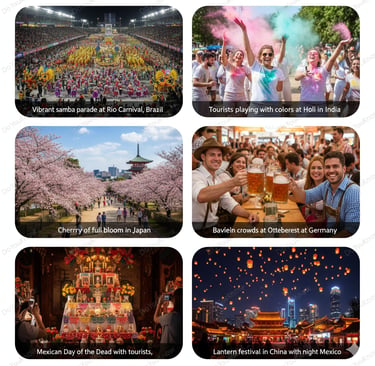Do You Know How Cultural Festivals Are Attracting Tourists Worldwide
Explore how cultural festivals across the globe are shaping modern tourism trends, attracting millions of travelers, boosting economies, and preserving traditions in the digital age.
WORLD & POLITICS
Do You Know Team
9/27/20256 min read


When people think about traveling, images of famous monuments, scenic beaches, or luxury resorts often come to mind. Yet in recent years, a new driving force has emerged in the global tourism industry — cultural festivals. These festivals, whether rooted in ancient traditions or modern celebrations, have transformed into powerful magnets pulling millions of tourists across borders.
The Rio Carnival in Brazil, Oktoberfest in Germany, Holi in India, Cherry Blossom Festivals in Japan, Día de los Muertos in Mexico, and countless others are no longer just local or regional events; they are now global phenomena. For international travelers, these festivals promise something deeper than sightseeing — they offer an immersion into the soul of a culture. Cultural festivals are not limited to music and dance. They encompass food, heritage, rituals, art, theater, fashion, and even spirituality. They give tourists something that no museum or city tour can fully replicate: the chance to live like a local, even if only for a few days. In the process, they generate billions of dollars, create jobs, preserve cultural identities, and influence global travel trends.
The global tourism market is increasingly shaped by these festivals. According to recent industry reports, over 40% of international tourists cite cultural experiences as a key motivation for travel. And at the heart of those cultural experiences are festivals — colorful, vibrant, unforgettable events that combine history and modernity in ways that captivate travelers from every corner of the globe.
This article explores how cultural festivals attract tourists worldwide, why they have become central to the tourism industry, the economic and social impact they create, the challenges they face, and what the future holds for festival-driven tourism.
The Historical Role of Festivals in Travel
Festivals are as old as civilization itself. From the Olympic Games in ancient Greece to harvest celebrations in Mesopotamia, humans have always gathered to celebrate milestones, worship deities, or mark seasonal changes. These gatherings, by their very nature, drew visitors from surrounding regions.
In medieval Europe, religious pilgrimages often coincided with large festivals. Pilgrims traveled hundreds of miles to witness holy relics and participated in grand feasts, processions, and performances. Similarly, in Asia, festivals linked to Buddhism, Hinduism, and Taoism have attracted devotees and travelers for centuries.
In other words, festival tourism is not new — it is only now more globalized, commercialized, and better supported by infrastructure like international airports, hotels, and digital marketing.
The Rise of Cultural Tourism in the 21st Century
Tourism in the 20th century largely revolved around destinations — the Eiffel Tower, the Taj Mahal, the Great Wall of China. But in the 21st century, especially after the digital revolution, travelers have become increasingly experience-oriented.
The post-pandemic era accelerated this shift. Tourists today want authentic, memorable, and emotionally engaging experiences. They want to participate, not just observe. Cultural festivals perfectly align with this demand.
For governments and tourism boards, festivals are a marketing goldmine. They create seasonal peaks, promote national culture, and diversify tourism beyond traditional attractions. For travelers, festivals provide an adventure that blends history, food, music, and human connection in ways no guided tour can offer.
Asia: The Powerhouse of Cultural Festivals
Asia, home to some of the world’s oldest civilizations, is a continent of festivals. For tourists, Asia is not only about visiting monuments like Angkor Wat or Mount Fuji but also about immersing themselves in traditions through celebrations.
India – Festivals of Colors and Lights
No country represents festival tourism better than India. With thousands of festivals celebrated across religions and regions, India has become a hub for cultural travelers. The two most famous festivals, Holi and Diwali, attract millions of tourists annually.
Holi, the festival of colors, transforms cities into giant celebrations. Tourists from Europe, North America, and Australia specifically plan trips to experience being drenched in color, dancing in the streets, and enjoying traditional food.
Diwali, the festival of lights, is equally popular. Tourists witness a spiritual celebration with fireworks, diyas, sweets, and cultural performances.
Other festivals like Durga Puja in Kolkata, Pushkar Camel Fair in Rajasthan, and Onam in Kerala provide niche experiences, blending religion, food, music, and art.
Japan – A Blend of Tradition and Aesthetics
In Japan, cultural tourism is synonymous with seasonal festivals. The Cherry Blossom Festival (Hanami) is one of the world’s most photographed cultural events. Tourists flock to Tokyo, Kyoto, and Osaka to witness parks filled with blooming sakura trees.
Other festivals like Gion Matsuri in Kyoto, Nebuta Matsuri in Aomori, and snow festivals in Hokkaido attract international tourists with their parades, lanterns, and sculptures.
China – Ancient Traditions in Modern Times
China’s Chinese New Year (Spring Festival) is celebrated not only domestically but globally in cities like Singapore, New York, and London. Tourists enjoy dragon dances, fireworks, red lanterns, and food markets.
The Mid-Autumn Festival, Dragon Boat Festival, and Harbin Ice Festival also attract millions of tourists annually.
Europe: Festivals of Heritage and Celebration
Europe is one of the most visited continents in the world, and festivals play a crucial role in tourism.
Germany – Oktoberfest
Munich’s Oktoberfest is not only the world’s biggest beer festival but also a cultural celebration of Bavarian heritage. Millions of tourists dress in traditional outfits, drink beer, eat pretzels, and dance to folk music. The economic impact is enormous, generating over €1 billion annually.
Spain – Festivals of Energy
Spain is known for vibrant festivals such as La Tomatina in Buñol, where tourists participate in massive tomato fights, and the Running of the Bulls in Pamplona. Meanwhile, Semana Santa (Holy Week) in Seville attracts religious pilgrims and cultural tourists alike.
Italy, France, and the UK
Italy’s Venice Carnival, France’s Cannes Film Festival, and Scotland’s Edinburgh Festival Fringe are world-famous, attracting millions of international tourists. These events combine art, theater, and local traditions, making Europe a hub for festival-driven tourism.
The Americas: Spectacle and Spirit
Brazil – Rio Carnival
No festival epitomizes global tourism like the Rio Carnival. Known as the world’s biggest party, it features samba parades, music, and dance, attracting over two million people per day. Tourists travel from every continent to experience the energy of Rio.
Mexico – Day of the Dead
Mexico’s Día de los Muertos (Day of the Dead) blends indigenous traditions with Catholic beliefs. Tourists are drawn by colorful skulls, altars, parades, and unique rituals celebrating ancestors.
USA – A Blend of Modern Festivals
The USA has created modern cultural festivals that attract global tourists — Mardi Gras in New Orleans, Burning Man in Nevada, and Coachella in California. These events combine culture, art, and music, making them international attractions.
Africa: Festivals of Tradition and Identity
Africa’s festivals are rooted in tradition and spirituality.
Morocco’s Fez Festival of World Sacred Music attracts tourists interested in music and spirituality.
Nigeria’s Osun-Osogbo Festival celebrates Yoruba traditions and draws global cultural enthusiasts.
South Africa hosts modern music and arts festivals like Cape Town International Jazz Festival, blending tradition with modern appeal.
Oceania: Festivals of Nature and Culture
Australia and New Zealand are increasingly recognized for their festivals.
Sydney’s Vivid Festival lights up the city with art and music, attracting tourists from Asia and Europe.
New Zealand’s Māori cultural festivals draw visitors interested in indigenous traditions, storytelling, and performances.
The Economic Impact of Festivals
Cultural festivals contribute billions to the global tourism economy. They:
Generate revenue for hotels, airlines, restaurants, and local businesses.
Create seasonal peaks, boosting jobs and sales.
Encourage long stays, as tourists often extend trips before or after festivals.
For instance:
Oktoberfest generates over €1.2 billion annually.
Rio Carnival adds billions to Brazil’s GDP.
Holi and Diwali boost India’s domestic and international tourism spending.
Tourist Behavior: Why Festivals Attract Travelers
Festivals attract tourists because they offer:
Immersion into local traditions.
Unique, once-in-a-lifetime experiences.
Social media-worthy visuals (colors of Holi, lanterns of Japan, costumes of Rio).
Authentic connections with locals.
Festivals transform tourists from passive observers into active participants, which creates lasting emotional connections.
Challenges of Festival Tourism
Overtourism: Popular festivals sometimes strain local infrastructure.
Commercialization: The essence of traditions may be diluted.
Environmental concerns: Waste, carbon emissions, and sustainability issues.
Safety risks: Managing large crowds is always a challenge.
The Future of Festival Tourism
The future lies in sustainability and digital integration. Festivals are adopting eco-friendly practices, limiting plastic use, and creating crowd-control systems. Some festivals are exploring virtual participation through live streaming and VR, expanding access without overcrowding.
FAQs
Q1: What is cultural tourism?
Cultural tourism is travel that focuses on experiencing a destination’s traditions, heritage, and festivals.
Q2: Which festivals attract the most tourists worldwide?
Rio Carnival, Oktoberfest, Holi, Diwali, Cherry Blossom Festivals, and Día de los Muertos are among the top.
Q3: How do festivals benefit local economies?
They generate billions in revenue, create jobs, and sustain small businesses.
Q4: What challenges does festival tourism face?
Overtourism, environmental impact, and commercialization are major concerns.
Q5: What is the future of festival tourism?
Sustainable practices, digital integration, and global marketing will shape the future.
Conclusion
Cultural festivals are not merely celebrations; they are gateways to identity, tradition, and human connection. From ancient rituals in Asia to modern carnivals in the Americas, festivals bridge cultures, preserve heritage, and create unforgettable experiences for travelers.
As global tourism evolves, cultural festivals will remain central, attracting millions while shaping economies and societies. They prove that the true spirit of travel lies not just in places but in shared human experiences.
#CulturalTourism #FestivalTourism #GlobalFestivals #TourismGrowth #WorldTravelTrends #HeritageTourism #TravelExperiences #CulturalEvents2025 #DoYouKnow
Knowledge
Empowering minds with reliable educational content daily.
Newsletter Signup
© 2025 DoYouKnow. All rights reserved.
Stay Ahead of the Trends – Join Our Newsletter
